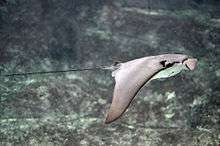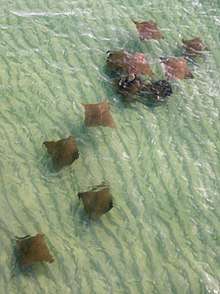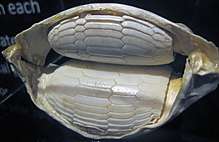Cownose ray
The cownose ray (Rhinoptera bonasus) is a species of eagle ray found throughout a large part of the western Atlantic and Caribbean, from New England, United States to southern Brazil (East Atlantic populations are now generally considered a separate species, R. marginata). Cownose rays grow rapidly, and male rays often reach about 35 inches (89 cm) in width and weigh 26 pounds (12 kg). Females typically reach 28 inches (71 cm) in width and weigh 36 pounds (16 kg). These rays also belong to the order Myliobatiformes, a group that is shared by bat rays, manta rays, and eagle rays.[1]
- For other species of cownose rays, see Rhinoptera.
| Cownose ray | |
|---|---|
 | |
| Scientific classification | |
| Kingdom: | |
| Phylum: | |
| Class: | |
| Subclass: | |
| Order: | |
| Family: | |
| Genus: | |
| Species: | R. bonasus |
| Binomial name | |
| Rhinoptera bonasus (Mitchill, 1815) | |
Taxonomy
Rhinoptera bonasus, comes from the Greek derivation of the word parts.
"rhinos"- nose
"pteron"- wing
"bonasos"- bison
Gestation and reproductive behavior
Cownose rays breed from June through October. A large school of cownose rays gather of varying ages and sexes in shallow waters. A female will swim with the edges of her pectoral fins sticking out of the water, with male cownose rays following her trying to grasp the fins to mate.[2]
The embryo grows within its mother with its wings folded over its body. Initially it is nourished by an egg yolk, although the uterine secretions of the mother nourish it later in its development. The length of gestation is disputed, but it is believed to last between 11 and 12 months and is variable. At full term, the offspring are born live, exiting tail first.

Lifespan
Sexual maturity for both males and females is reached around 4 to 5 years of age. In the Gulf of Mexico, females live up to 18 years, and males only live up to 16 years.[3]
Size and appearance
The cownose ray is 11 to 18 inches (28 to 46 cm) in width at birth. A mature specimen can grow to 45 inches (1.1 m) in width, and weigh 50 pounds (23 kg) or more. There is some controversy over the size that a mature cownose ray can reach. A ray reaching a span of 84 inches (2.1 m) has been recorded.[4] The cownose ray is often mistaken for being a shark by beach-goers. This is due to the tips of the rays fins sticking out of the water, often resembling the dorsal fin of a shark.[1]
A cownose ray is typically brown-backed with a whitish or yellowish belly. Although its coloration is not particularly distinctive, its shape is easily recognizable. It has a broad head with wide-set eyes, and a pair of distinctive lobes on its subrostral fin. It also has a set of dental plates designed for crushing clams and oyster shells. When threatened the cownose ray can use the barb at the base of its tail to defend itself from the threat.[2]
A cownose ray has a spine with a toxin, close to the ray's body. This spine has teeth lining its lateral edges, and is coated with a weak venom that causes symptoms similar to that of a bee sting.[4]
Feeding habits
The cownose ray feeds upon clams, oysters, hard clams and other invertebrates. It uses two modified fins on its front side to produce suction, which allows it to draw food into its mouth, where it crushes its food with its dental plates. Cownose rays typically swim in groups, which allows them to use their synchronized wing flaps to stir up sediment and expose buried clams and oysters.
The cownose ray prefers to feed either in the early morning hours, or in the late afternoon hours; when the waves are calm and visibility is higher than during the day. The cownose ray has a jaw that reflects its diet of: benthic bivalve mollusks, crustaceans, and polychaetes. Their jaws are extremely robust and have teeth with a hardness comparable to that of cement, allowing them to eat hard shells. The feeding habits of cownose rays is cause for increasing concern, as they are known for destroying oyster beds that are already being destroyed largely by human pollution. The cownose rays destruction of large oyster beds only further puts oyster beds at risk.[5]
Migration

The cownose ray often migrates from the Gulf of Mexico to Trinidad, Venezuela, and Brazil.[4] The Atlantic migration pattern consists of the cownose rays moving north in late Spring and moving south in late Fall.
Migration may be influenced by water temperature and sun orientation, which explains the seasonal migration pattern. Southern migration may be influenced by solar orientation and Northern migration may be influenced by the change in water temperature.
It is unknown whether their migratory behavior is due to feeding or premigratory mating activity.[2]
The cownose ray is also present in areas such as Maryland and Virginia, and can be seen migrating and schooling, as it is not uncommon for them to swim near the surface, despite feeding mostly on the bottom. These schools can be seen and migration tracked via airplane as it is easy to see the schools from the sky. However, while the migration patterns can tracked, the exact reason for migration is currently unknown.[6]
Habitat
Cownose rays appear naturally in the Eastern and Western Atlantic Ocean. Within the Eastern Atlantic Ocean, the cownose ray can often be found in Mauritania, Senegal, and Guinea. In the Western Atlantic Ocean, they are located from Southern New England to Northern Florida in the United States, as well as throughout the Gulf of Mexico, Trinidad, Venezuela, and Brazil.
They live in brackish and marine habitats and can be found at depth up to 72 feet (22 m). They are social creatures and migrate extremely long distances, often traveling in schools.
Risk to humans
Stingrays, including the cownose ray, can pose a low to moderate risk to humans. Rays will lash their tails when threatened, posing a risk of being whipped. If threatened, the cownose ray can also use their barb as a weapon to sting the aggressor. A sting from a cownose ray can cause a very painful wound that requires medical attention once stung. While the sting is not usually fatal, it can be fatal if stung in the abdomen.[7] There is also a risk associated with eating meat from the sea animal that has not been prepared correctly. Shigella may be acquired from eating meat from a cownose ray that has been contaminated with the bacteria. This bacteria causes shigellosis, and can result in dysentery. Symptoms can include diarrhea, pain, fever, and possible dehydration.[5]
Predators
The cownose ray sits fairly high up on the food chain, and as a result only has a few natural predators. These predators include; cobia, bull sharks, , great hammerheads, and sandbar sharks, as well as humans.[8]
Commercial fishing
One solution to the cownose rays' destruction of oyster beds, as well as their overpopulation in certain areas, is to open the ray up for commercial fishing. However, since the means to fish them are difficult and expensive to obtain, and the meat of the rays has very little demand, this solution would most likely prove to be too expensive and yield too little of a profit for it to be a viable venture for any commercial fishermen. It is, however, often caught by hobby fishermen.[5]
Aquariums
Cownose rays can be seen in many public aquaria worldwide and are often featured in special 'touch tanks' where visitors can reach into a wide but shallow pool containing the fish, which have often had their barbs pinched or taken off (they eventually regrow, similar to human nails), making them safe enough to touch. The following aquariums and zoos are known to have a touch tanks featuring cownose rays (alone or with other fish):
USA
- Adventure Aquarium in Camden, New Jersey[9]
- Albuquerque Aquarium in Albuquerque, New Mexico
- Audubon Aquarium in New Orleans, Louisiana[10]
- Arizona-Sonora Desert Museum in Tucson, Arizona[11]
- Atlantic City Aquarium in Atlantic City, New Jersey[12]
- Aquarium of the Pacific in Long Beach, California
- Butterfly House and Aquarium in Sioux Falls, South Dakota
- California Academy of Sciences in San Francisco, California
- Children's Aquarium at Fair Park in Dallas, Texas
- Clearwater Marine Aquarium in Clearwater, Florida
- Downtown Aquarium, Denver in Denver, Colorado[13]
- Georgia Aquarium in Atlanta, Georgia[14]
- Henry Doorly Zoo in Omaha, Nebraska[15][16]
- Kansas City Zoo in Kansas City, Missouri
- Living Shores Aquarium in Glen, New Hampshire
- Long Island Aquarium and Exhibition Center in Riverhead, New York
- Lowry Park Zoo in Tampa, Florida
- Marine Science Center in Ponce Inlet, Florida
- Maritime Aquarium in Norwalk, Connecticut
- Mystic Aquarium in Mystic, Connecticut
- The New England Aquarium in Boston, Massachusetts
- New York Aquarium in Brooklyn, New York
- Newport Aquarium in Newport, Kentucky
- North Carolina Aquarium at Pine Knoll Shores in Emerald Isle, North Carolina
- Ocean Adventures in Gulfport, Mississippi
- Oklahoma City Zoo and Botanical Garden in Oklahoma City, Oklahoma
- Phoenix Zoo in Phoenix, Arizona
- Rooster Cogburn Ostrich Ranch in Picacho, Arizona[17]
- Saint Louis Zoo in St. Louis, Missouri[18]
- San Antonio Aquarium in San Antonio, Texas[19]
- SeaWorld Orlando in Orlando, Florida
- Shedd Aquarium in Chicago, Illinois
- Tennessee Aquarium in Chattanooga, Tennessee
- Texas State Aquarium in Corpus Christi, Texas[20]
- Toledo Zoo in Toledo, Ohio
- Tropicana Field in St. Petersburg, Florida[21]
- Turtle Back Zoo in West Orange, New Jersey[22]
- Wonders of Wildlife Museum & Aquarium in Springfield, Missouri
- ViaAquarium in Rotterdam, New York
- Virginia Aquarium in Virginia Beach, Virginia
Canada
- Aquarium of Quebec in Quebec City[23]
- Granby Zoo in Granby
- Ripley's Aquarium of Canada in Toronto, Ontario[24]
- The Vancouver Aquarium in Vancouver, British Columbia[25]
- Assiniboine Park Zoo in Winnipeg, Manitoba[26]
In Pop Culture
References
- "Cownose Ray Facts". Saint Louis Zoo. Retrieved September 25, 2018.
- Kittle, Kimberly. "University of Florida". Rhinoptera bonasus. Florida museum of Natural History.
- Puglisi, Melany P. (August 1, 2008). "Smithsonian Marine Station at Fort Pierce". Rhinopera bonasus.
- Ball, Michael (July 16, 2012). "Commercial Fishery Species Guide" (PDF). NOAA Fisheries Service Apex Predator Program. NOAA.
- "Rhinoptera bonasus". Florida Museum. 2017-05-11. Retrieved September 25, 2018.
- Smith, Joseph W.; Merriner, John V. (1987). "Age and growth, movements and distribution of the cownose ray, Rhinoptera bonasus, in Chesapeake Bay". Estuaries. 10 (2): 153–164. doi:10.2307/1352180. JSTOR 1352180.
- "Stingray". Encyclopaedia Britannica. Retrieved September 25, 2018.
- "Cownose Ray". Chesapeake Bay Program.
- "Adventure Aquarium - Camden, NJ". www.adventureaquarium.com. Retrieved 23 August 2018.
- "Stingray Touchpool | Aquarium Exhibits | Explore Aquarium".
- "Stingray Touch - Arizona-Sonora Desert Museum".
- "Cownose Ray - Atlantic City Aquarium".
- "Downtown Aquarium Denver Visitor Info". Retrieved 5 June 2019.
- "SeaTrek Helmet Diving at OdySea Aquarium". Retrieved 23 August 2018.
- "Archived copy". Archived from the original on 2017-06-29. Retrieved 2017-05-30.CS1 maint: archived copy as title (link)
- writer, Carol Bicak / World-Herald staff. "You can touch a stingray at new exhibit at Omaha's Henry Doorly Zoo & Aquarium". Retrieved 23 August 2018.
- "Petting Zoo - Rooster Cogburn Ostrich Ranch".
- "Stingrays at Caribbean Cove presented by SSM Health". Retrieved 5 June 2019.
- "The San Antonio Aquarium". Retrieved 2018-04-07.
- "Texas State Aquarium". Retrieved 2017-08-16.
- "Cownose Sting Ray". Retrieved 2011-01-09.
- https://turtlebackzoo.com/animals/. Retrieved 12 January 2020. Missing or empty
|title=(help) - "Quebec Aquarium". Quebec Aquarium. Retrieved 1 August 2017.
- "Ray Bay - Ripley's Aquarium of Canada". Ripley's Aquarium of Canada. Retrieved 1 August 2017.
- "Vancouver Aquarium - Discover Rays". www.vanaqua.org.
- "Stingray Beach - Assiniboine Park Zoo". Assiniboine Park Zoo. Retrieved 20 June 2019.
- Barker, A.S. (2006). "Rhinoptera bonasus". IUCN Red List of Threatened Species. 2006: e.T60128A12310195. doi:10.2305/IUCN.UK.2006.RLTS.T60128A12310195.en. Database entry includes a lengthy justification of why this species is near threatened.
- Froese, Rainer and Pauly, Daniel, eds. (2005). "Rhinoptera bonasus" in FishBase. August 2005 version.
- Florida Museum of Natural History Ichthyology Dept: Cownose Rays
| Wikimedia Commons has media related to Rhinoptera bonasus. |
